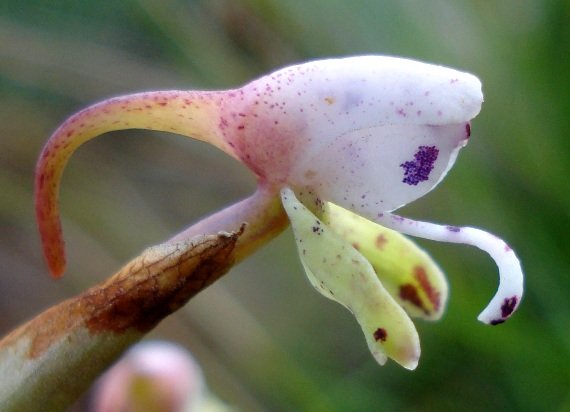Disa klugei flower

Author: Ivan Lätti
Photographer: Judd Kirkel Welwitch
The alien-looking flower of Disa klugei has a large, ovoid hood made up of the three upper tepals: There is the broad, rounded dorsal sepal on top and the two lateral petals positioned half inside this sepal on its flanks.
The three equally fleshy lower tepals completing the corolla protrude individually and look very different: The two oblong and slightly concave lateral sepals spread forwards and sideways but half-heartedly, while the third petal, called the lip, is in this species tongue-like, stuck out straight between them. The lip has a rough edge and rounded tip.
Two arty floral parts curve conspicuously outwards and downwards from the flower: at the back the long, cylindrical spur becomes thinner towards its tip; in the front the lip first elongates forward, then curves down strongly, becoming thicker towards its tip.
Flower colour is a varied affair on this flower:
In picture the lip and most of the hood are white, apart from a few large, dark blue and purple blotches, as well as a sparse covering of tiny scattered spots.
The lateral sepals are creamy yellow-green with a hint of translucence, apart from their own share of large and small blotches and flecks, including colours of brown, black, purple and more.
The back of the hood has a pinkish purple sheen and, of course, the almost ubiquitous speckling. The speckles grade onto the spur in tiny, variously shaped markings, mainly red-purple on a semi-translucent background.
After several colour changes along the length of the spur (reminiscent of the colours changing on jukeboxes that played popular songs in cafes long ago), it concludes in a rusty, red-brown tip. Along the way it sports tints including lemon yellow and unnamed green, like rainbows that have either a few colours with common names or an endless range of shades, the names of which are either lacking or sources of controversy.
The ovary that holds this carnival in the air is modestly clothed in a tight-fitting, pale green bract with pointed tip, dried and browned in its upper parts.

